
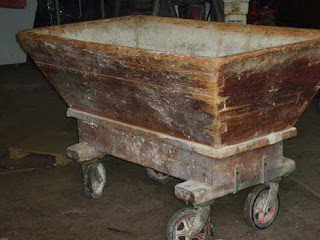 Es indudable que el pan era a principios del siglo pasado un alimento fundamental e imprescindible, sobre todo en este pueblo, si actualmente también lo es, imaginémoslo antes cuando no se podía comprar hecho y por tanto era esencial fabricar el pan, una autentica obra de artesanía, por lo que practicamente cada vecino tenia su horno correspondiente para esta labor, por tanto una vez hecha la malla y separado en la era el grano de la paja, el centeno se echaba en las "quilmas", unos sacos gordos de lino fabricados también artesanalmente en casa, midiéndolo en "tegas" antes de introducirlo en ellos.Estos sacos se transportaban a casa y el grano era guardado en grandes arcas, antes de llevarlo al molino para convertirlo en harina y volver a guardarlo en otra arca.En épocas anteriores se amasaba solo con harina de centeno resultando un pan con un color oscuro, a partir de mediados del siglo veinte era mezclada con harina de trigo y posteriormente comenzó a hacerse pan de trigo.La harina de centeno se amasaba y se dejaba esponjar, amasando una cantidad como para hacer 10 hogazas de un kilo aproximadamente, lo que daría para comer durante 15 dias.El elemento principal para amasar es la levadura, que se obtenía de la masada anterior, guardándo un trozo de masa, colocándola en un perol y colocando el perol junto al fuego para que fermentara, guardándola en la artesa una vez hubiera enfriado.
Es indudable que el pan era a principios del siglo pasado un alimento fundamental e imprescindible, sobre todo en este pueblo, si actualmente también lo es, imaginémoslo antes cuando no se podía comprar hecho y por tanto era esencial fabricar el pan, una autentica obra de artesanía, por lo que practicamente cada vecino tenia su horno correspondiente para esta labor, por tanto una vez hecha la malla y separado en la era el grano de la paja, el centeno se echaba en las "quilmas", unos sacos gordos de lino fabricados también artesanalmente en casa, midiéndolo en "tegas" antes de introducirlo en ellos.Estos sacos se transportaban a casa y el grano era guardado en grandes arcas, antes de llevarlo al molino para convertirlo en harina y volver a guardarlo en otra arca.En épocas anteriores se amasaba solo con harina de centeno resultando un pan con un color oscuro, a partir de mediados del siglo veinte era mezclada con harina de trigo y posteriormente comenzó a hacerse pan de trigo.La harina de centeno se amasaba y se dejaba esponjar, amasando una cantidad como para hacer 10 hogazas de un kilo aproximadamente, lo que daría para comer durante 15 dias.El elemento principal para amasar es la levadura, que se obtenía de la masada anterior, guardándo un trozo de masa, colocándola en un perol y colocando el perol junto al fuego para que fermentara, guardándola en la artesa una vez hubiera enfriado.  La labor de amasar solia realizarse en una mesa o en una masera, que era una especie de arca con patas, esparciendo harina a lo largo de la artesa y echando la levadura y un poco de agua con sal, dándole vueltas y arrastrando poco a poco harina hacia la masa para hacerla mas compacta, se iba añadiendo agua a medida que se iba terminando y se continuaba amasando y asi sucesivamente hasta terminar con toda la harina, teniendo en cuenta que cuanto mas iba subiendo el volumen de la masa mas esfuerzo habia que hacer para manejarla.Una vez amasada toda la pasta, se cortaba un trozo, se espolvoreaba con harina, se amasaba un poco más y se dejaba a un lado haciendo lo mismo con el resto de los trozos hasta terminar toda la masa.Una vez hechas las hogazas se tapaban con con una sabana a la espera de introducirlas en el horno, en el que se quemaban ramas de uz (brezo) y otros arbustos hasta caldearlo, para ya una vez caliente retirar las brasas a la puerta del horno, barrer el fondo e introducir las hogazas, que una vez cocidas se guardarán en una artesa hasta su consumo.
La labor de amasar solia realizarse en una mesa o en una masera, que era una especie de arca con patas, esparciendo harina a lo largo de la artesa y echando la levadura y un poco de agua con sal, dándole vueltas y arrastrando poco a poco harina hacia la masa para hacerla mas compacta, se iba añadiendo agua a medida que se iba terminando y se continuaba amasando y asi sucesivamente hasta terminar con toda la harina, teniendo en cuenta que cuanto mas iba subiendo el volumen de la masa mas esfuerzo habia que hacer para manejarla.Una vez amasada toda la pasta, se cortaba un trozo, se espolvoreaba con harina, se amasaba un poco más y se dejaba a un lado haciendo lo mismo con el resto de los trozos hasta terminar toda la masa.Una vez hechas las hogazas se tapaban con con una sabana a la espera de introducirlas en el horno, en el que se quemaban ramas de uz (brezo) y otros arbustos hasta caldearlo, para ya una vez caliente retirar las brasas a la puerta del horno, barrer el fondo e introducir las hogazas, que una vez cocidas se guardarán en una artesa hasta su consumo.  BROA O PAN DE MILLO: Resulta difícil conseguir hoy en día pan de maíz (echo artesanalmente) aúnque algunas panaderías acostumbran a cocerlo, no tiene nada que ver con el pan artesano de toda la vida. El Pan de Millo es ideal para acompañar cualquier plato típico gallego, especial para acompañar la carne de cerdo y magnífico para hacer tostado y untar con mantequilla. También resulta indispensable para comer los "Rixons" de Cerdo.
BROA O PAN DE MILLO: Resulta difícil conseguir hoy en día pan de maíz (echo artesanalmente) aúnque algunas panaderías acostumbran a cocerlo, no tiene nada que ver con el pan artesano de toda la vida. El Pan de Millo es ideal para acompañar cualquier plato típico gallego, especial para acompañar la carne de cerdo y magnífico para hacer tostado y untar con mantequilla. También resulta indispensable para comer los "Rixons" de Cerdo.
INGREDIENTES: Harina de Maiz, Harina de Centeno, Levadura y Sal.
PREPARACIÓN:Se harina en proporción 3 a 1, mezclándose con la levadura y amasándo todo en la masera, añadimos sal y dejamos lavedar.Una vez levedada la masa, pasadas unas horas y con el horno (a ser posible de leña) caliente, ponemos las piezas de pan dentro para su cocción.Después de una hora u hora y media, abrimos el horno y quitamos el pan con la panera.
MASA DE BRONA (Usada también para hacer pan de brona).
INGREDIENTES: 300 grms. de harina de maiz, 150 grms. de harina de trigo, 75 grms. de harina de centeno, 250 cc de agua tibia, 30 grms. de levadura prensada de panaderia, Una cucharadilla de sal, 12 cucharadas soperas de aceite del sofrito (solo cuando sea para hacer empanadas).
TRUCOS Y CONSEJOS: Esta masa va muy bien para mariscos (berberechos, zamburiñas...) y algunos tipos de pescado (sardinas, parrochas...).La harina de maiz la puedes usar amarilla o blanca. Te recomendamos la blanca, pues tiene un sabor mas suave, pero siempre del pais, o sea natural y artesana; No te recomendamos la harina fina de fábrica que venden en las herboristerías y tiendas de dietética, ya que esas harinas son para otros usos y no te saldrÍa con la textura y sabor que debe de tener.
Con esta masa, procediendo en todo igual pero prescindiendo del aceite, puedes elaborar el PAN DE BRONA. Para hacerlo, una vez amasado bolea la pieza de masa formando una bola bien prieta y déjala fermentar en lugar templado tapada y espolvoreada con harina hasta que haya duplicado de sobra su volumen. Luego cuecela en el horno previamente caliente a 200 grados, hasta que esté bien tostada su corteza y de color chocolate. Procura que el bollo de masa no se desparrame demasiado durante la fermentación.
ASI SE HACE: Mezcla bien las harinas y ponlas en un bol, haz un hoyo en el centro y añade en él el agua, el aceite y la sal. Mézclalo poco a poco con una cuchara de madera y luego comienza a amasar a mano sobre una superficie lisa hasta conseguir una masa no demasiado blanda, pero suave y no pegajosa, añadiendo algo mas de agua o harina si hiciese falta. Tenemos que decirte que esta masa no cogera liga ni velo como la de trigo, ya que la harina de maiz es mas vasta. Forma una bola bien prieta y déjala reposar como 1 hora antes de usarla hasta que haya duplicado su volumen. Si vas a hacer empanadas amasala de nuevo gramándola con algunas cucharadas mas de aceite antes de proceder a estirarla.Esta masa es bastante difícil de extender, debido a su vastedad que la hace romper. Posiblemente tengas que apañartelas para componer la empanada por trozos, es decir, con el molde ya preparado y engrasado ir estirándola y si rompiese ir colocando amañadamente como puedas los trozos en el molde uniéndolos luego con los dedos. Puede ayudarte lo siguiente: Enharina muy bien un papel aluminio o de barba y estira sobre él la masa espolvoreando luego ligeramente su superficie con harina, enrollala con el rodillo junto con el papel y colocala de esta forma en el molde, rellenala y estira igualmente la masa de la tapa (tapándola, desenvolviéndola con ayuda del rodillo pero depositándola al revés).

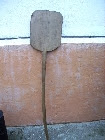 É indubidable que o pan era a principios do século pasado un alimento fundamental e imprescindible, sobre todo nesta vila, se actualmente tamén éo, imaxinémolo antes cando non si podía comprar feito e por tanto era esencial fabricar o pan, unha autentica obra de artesanía, polo que practicamente cada veciño tenia o seu forno correspondente para este labor, polo tanto unha vez feita a malla e separado na era o gran da palla, o centeo botábase nas "quilmas", uns sacos gordos de liño fabricados tamén artesanalmente na casa, medíndoo en "tegas" antes de introducilo neles.Estes sacos se transportaban a casa e o gran era gardado en grandes arcas, antes de levalo ao muíño para convertelo en fariña e volver a gardalo noutra arca.En épocas anteriores amasábase só con fariña de centeo resultando un pan cunha cor escuro, a partir de mediádevos do século vinte era mesturada con fariña de trigo e posteriormente comezou a facerse pan de trigo.A fariña de centeo amasábase e deixábase esponjar, amasando unha cantidade como para facer 10 hogazas dun quilo aproximadamente, o que daría para comer durante 15 dias.O elemento principal para amasar é a levadura, que se obtiña da masada anterior, guardándo un anaco de masa, colocándoa nun perol e colocando o perol xunto á lume para que levedase, gardándoa na artesa unha vez houbese enfriado.
É indubidable que o pan era a principios do século pasado un alimento fundamental e imprescindible, sobre todo nesta vila, se actualmente tamén éo, imaxinémolo antes cando non si podía comprar feito e por tanto era esencial fabricar o pan, unha autentica obra de artesanía, polo que practicamente cada veciño tenia o seu forno correspondente para este labor, polo tanto unha vez feita a malla e separado na era o gran da palla, o centeo botábase nas "quilmas", uns sacos gordos de liño fabricados tamén artesanalmente na casa, medíndoo en "tegas" antes de introducilo neles.Estes sacos se transportaban a casa e o gran era gardado en grandes arcas, antes de levalo ao muíño para convertelo en fariña e volver a gardalo noutra arca.En épocas anteriores amasábase só con fariña de centeo resultando un pan cunha cor escuro, a partir de mediádevos do século vinte era mesturada con fariña de trigo e posteriormente comezou a facerse pan de trigo.A fariña de centeo amasábase e deixábase esponjar, amasando unha cantidade como para facer 10 hogazas dun quilo aproximadamente, o que daría para comer durante 15 dias.O elemento principal para amasar é a levadura, que se obtiña da masada anterior, guardándo un anaco de masa, colocándoa nun perol e colocando o perol xunto á lume para que levedase, gardándoa na artesa unha vez houbese enfriado. 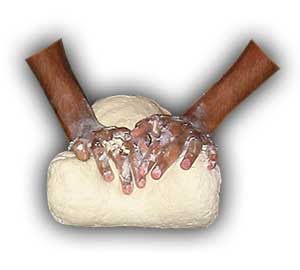 O labor de amasar solia realizarse nunha mesa ou nunha masera, que era unha especie de arca con patas, espallando fariña ao longo da artesa e botando a levadura e un pouco de auga con sal, dándolle voltas e arrastrando aos poucos fariña para a masa para facela mais compacta, se ía engadindo auga a medida que se ía terminando e continuábase amasando e asi sucesivamente ata terminar con toda a fariña, tendo en conta que canto mais ía subindo o volume da masa mais esforzo habia que facer para manexala.Unha vez amasada toda a pasta, cortábase un anaco, se espolvoreaba con fariña, amasábase un pouco máis e deixábase a unha beira facendo o mesmo co resto dos anacos ata terminar toda a masa.Unha vez feitas as hogazas tapábanse con cunha sabana á espera de introducilas no forno, no que se queimaban ramas de urce (breixo) e outros arbustos ata caldearlo, para xa unha vez quente retirar as brasas á porta do forno, varrer o fondo e introducir as hogazas, que unha vez cocidas se gardarán nunha artesa ata o seu consumo.
O labor de amasar solia realizarse nunha mesa ou nunha masera, que era unha especie de arca con patas, espallando fariña ao longo da artesa e botando a levadura e un pouco de auga con sal, dándolle voltas e arrastrando aos poucos fariña para a masa para facela mais compacta, se ía engadindo auga a medida que se ía terminando e continuábase amasando e asi sucesivamente ata terminar con toda a fariña, tendo en conta que canto mais ía subindo o volume da masa mais esforzo habia que facer para manexala.Unha vez amasada toda a pasta, cortábase un anaco, se espolvoreaba con fariña, amasábase un pouco máis e deixábase a unha beira facendo o mesmo co resto dos anacos ata terminar toda a masa.Unha vez feitas as hogazas tapábanse con cunha sabana á espera de introducilas no forno, no que se queimaban ramas de urce (breixo) e outros arbustos ata caldearlo, para xa unha vez quente retirar as brasas á porta do forno, varrer o fondo e introducir as hogazas, que unha vez cocidas se gardarán nunha artesa ata o seu consumo. 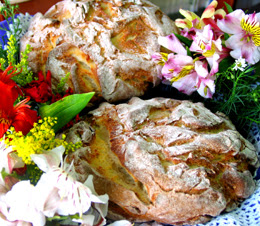 BROA OU PAN DE MILLO: Resulta difícil conseguir hoxe en día pan de millo (boto artesanalmente) aúnque algunhas panaderías afan a cocelo, non ten nada que ver co pan artesán de toda a vida. O Pan de Millo é ideal para acompañar calquera prato típico galego, especial para acompañar a carne de porco e magnífico para facer torrado e untar con manteiga. Tamén resulta indispensable para comer os "Rixons" de Porco.
BROA OU PAN DE MILLO: Resulta difícil conseguir hoxe en día pan de millo (boto artesanalmente) aúnque algunhas panaderías afan a cocelo, non ten nada que ver co pan artesán de toda a vida. O Pan de Millo é ideal para acompañar calquera prato típico galego, especial para acompañar a carne de porco e magnífico para facer torrado e untar con manteiga. Tamén resulta indispensable para comer os "Rixons" de Porco.INGREDIENTES: Fariña de Maiz, Fariña de Centeo, Levadura e Sal.
PREPARACIÓN:Se fariña en proporción 3 a 1, mesturándose coa levadura e amasándo todo na masera, engadimos sal e deixamos lavedar.Unha vez levedada a masa, pasadas unhas horas e co forno (a ser posible de leña) quente, poñemos as pezas de pan dentro para seu cocción.Despois dunha hora ou hora e media, abrimos o forno e tiramos o pan coa panera.
MASA DE BRONA (Usada tamén para facer pan de brona).
INGREDIENTES: 300 grms. de fariña de maiz, 150 grms. de fariña de trigo, 75 grms. de fariña de centeo, 250 cc de auga morna, 30 grms. de levadura prensada de panaderia, Unha cucharadilla de sal, 12 culleradas sopeiras de aceite do rustrido (só cando sexa para facer empanadas).
TRUCOS E CONSELLOS: Esta masa vai moi ben para mariscos (berberechos, zamburiñas...) e algúns tipos de pescado (sardinas, parrochas...).A fariña de maiz pódela usar amarela ou branca. Recomendámosche a branca, pois ten un sabor mais maino, pero sempre do pais, ou sexa natural e artesá; Non recomendámosche a fariña fina de fábrica que venden nas herboristerías e tendas de dietética, xa que esas fariñas son para outros usos e non sairíache coa textura e sabor que debe de ter. Con esta masa, procedendo en todo igual pero prescindindo do aceite, podes elaborar o PAN DE BRONA. Para facelo, unha vez amasado bolea a peza de masa formando unha bóla ben apertada e deíxaa levedar en lugar morno tapada e espolvoreada con fariña ata que faia duplicado de sobra o seu volume. Logo cuecela no forno previamente quente a 200 graos, ata que estea ben torrada a súa cortiza e de cor chocolate. Procura que o bollo de masa non se desparrame demasiado durante a fermentación.
ASI FAISE: Mestura ben as fariñas e ponlas nun bol, fai un foxo no centro e engade nel o auga, o aceite e o sal. Mestúrao aos poucos cunha culler de madeira e logo comeza a amasar a man sobre unha superficie lisa ata conseguir unha masa non demasiado branda, pero maino e non pegañenta, engadindo algo mais de auga ou fariña se fixese falta. Temos que dicirche que esta masa non cogera liga nin veo como a de trigo, xa que a fariña de maiz é mais vasta. Forma unha bóla ben apertada e deíxaa repousar como 1 hora antes de usala ata que faia duplicado o seu volume. Se vas facer empanadas amasala de novo gramándola con algunhas culleradas mais de aceite antes de proceder a estirala.Esta masa é bastante difícil de estender, debido a seu vastedad que faia romper. Posiblemente teñas que apañartelas para compoñer a empanada por anacos, é dicir, co molde xa preparado e engraxado ir estirándoa e se rompese ir colocando amañadamente como poidas os anacos no molde uníndoos logo cos dedos. Pode axudarche o seguinte: Enfariña moi ben un papel aluminio ou de barba e estira sobre el a masa espolvoreando logo lixeiramente a súa superficie con fariña, enrollala co rolo xunto co papel e colocala desta forma no molde, rellenala e estira igualmente a masa da tapa (tapándoa, desenvolvéndoa con axuda do rolo pero depositándoa ao revés).

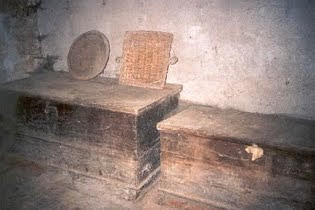 Il est indubitable que le pain était à des principes del siècle passé un aliment fondamental et indispensable, sur tout dans ce peuple, si actuellement aussi il l'est, nous l'imaginions avant quand on ne pouvait pas acheter fait et par tant il était essentiel de fabriquer le pain, une authentique oeuvre d'artisanat, par ce que pratiquement chaque voisin tenia son four correspondant pour cette tâche, pour tant une fois faite la maille et séparé dans elle était le grain de la paille, le seigle était jetée artisanalement avant dans les "quilmas", des couches grasses de toile fabriquées aussi en maison, en le mesurant dans "tegas" de l'introduire en ces derniers.Ces couches étaient transportées à maison et le grain était gardé dans de grandes poitrines, avant de le porter au moulin pour le transformer en farine et le garder à nouveau dans une autre poitrine.à des époques précédentes on malaxait seulement avec farine de seigle en résultant un pain avec une couleur obscure, à partir d'à moitié du siècle vingt il était mélangé avec farine de blé et postérieurement a commencé à faire pain de blé.La farine de seigle était malaxée et il était laissé gonfler, en malaxant une quantité comme pour faire 10 hogazas d'un kilo approximativement, ce qui donnerait pour manger pendant 15 jours.L'élément principal pour malaxer est la levure, qui était obtenue de de celle masada précédente, en gardant un morceau de masse, en la plaçant dans un perol et en plaçant le perol avec le feu pour qu'il fermente, en la gardant dans la cuvette une fois qu'il aura refroidi.
Il est indubitable que le pain était à des principes del siècle passé un aliment fondamental et indispensable, sur tout dans ce peuple, si actuellement aussi il l'est, nous l'imaginions avant quand on ne pouvait pas acheter fait et par tant il était essentiel de fabriquer le pain, une authentique oeuvre d'artisanat, par ce que pratiquement chaque voisin tenia son four correspondant pour cette tâche, pour tant une fois faite la maille et séparé dans elle était le grain de la paille, le seigle était jetée artisanalement avant dans les "quilmas", des couches grasses de toile fabriquées aussi en maison, en le mesurant dans "tegas" de l'introduire en ces derniers.Ces couches étaient transportées à maison et le grain était gardé dans de grandes poitrines, avant de le porter au moulin pour le transformer en farine et le garder à nouveau dans une autre poitrine.à des époques précédentes on malaxait seulement avec farine de seigle en résultant un pain avec une couleur obscure, à partir d'à moitié du siècle vingt il était mélangé avec farine de blé et postérieurement a commencé à faire pain de blé.La farine de seigle était malaxée et il était laissé gonfler, en malaxant une quantité comme pour faire 10 hogazas d'un kilo approximativement, ce qui donnerait pour manger pendant 15 jours.L'élément principal pour malaxer est la levure, qui était obtenue de de celle masada précédente, en gardant un morceau de masse, en la plaçant dans un perol et en plaçant le perol avec le feu pour qu'il fermente, en la gardant dans la cuvette une fois qu'il aura refroidi.

 Il est indubitable que le pain était à des principes del siècle passé un aliment fondamental et indispensable, sur tout dans ce peuple, si actuellement aussi il l'est, nous l'imaginions avant quand on ne pouvait pas acheter fait et par tant il était essentiel de fabriquer le pain, une authentique oeuvre d'artisanat, par ce que pratiquement chaque voisin tenia son four correspondant pour cette tâche, pour tant une fois faite la maille et séparé dans elle était le grain de la paille, le seigle était jetée artisanalement avant dans les "quilmas", des couches grasses de toile fabriquées aussi en maison, en le mesurant dans "tegas" de l'introduire en ces derniers.Ces couches étaient transportées à maison et le grain était gardé dans de grandes poitrines, avant de le porter au moulin pour le transformer en farine et le garder à nouveau dans une autre poitrine.à des époques précédentes on malaxait seulement avec farine de seigle en résultant un pain avec une couleur obscure, à partir d'à moitié du siècle vingt il était mélangé avec farine de blé et postérieurement a commencé à faire pain de blé.La farine de seigle était malaxée et il était laissé gonfler, en malaxant une quantité comme pour faire 10 hogazas d'un kilo approximativement, ce qui donnerait pour manger pendant 15 jours.L'élément principal pour malaxer est la levure, qui était obtenue de de celle masada précédente, en gardant un morceau de masse, en la plaçant dans un perol et en plaçant le perol avec le feu pour qu'il fermente, en la gardant dans la cuvette une fois qu'il aura refroidi.
Il est indubitable que le pain était à des principes del siècle passé un aliment fondamental et indispensable, sur tout dans ce peuple, si actuellement aussi il l'est, nous l'imaginions avant quand on ne pouvait pas acheter fait et par tant il était essentiel de fabriquer le pain, une authentique oeuvre d'artisanat, par ce que pratiquement chaque voisin tenia son four correspondant pour cette tâche, pour tant une fois faite la maille et séparé dans elle était le grain de la paille, le seigle était jetée artisanalement avant dans les "quilmas", des couches grasses de toile fabriquées aussi en maison, en le mesurant dans "tegas" de l'introduire en ces derniers.Ces couches étaient transportées à maison et le grain était gardé dans de grandes poitrines, avant de le porter au moulin pour le transformer en farine et le garder à nouveau dans une autre poitrine.à des époques précédentes on malaxait seulement avec farine de seigle en résultant un pain avec une couleur obscure, à partir d'à moitié du siècle vingt il était mélangé avec farine de blé et postérieurement a commencé à faire pain de blé.La farine de seigle était malaxée et il était laissé gonfler, en malaxant une quantité comme pour faire 10 hogazas d'un kilo approximativement, ce qui donnerait pour manger pendant 15 jours.L'élément principal pour malaxer est la levure, qui était obtenue de de celle masada précédente, en gardant un morceau de masse, en la plaçant dans un perol et en plaçant le perol avec le feu pour qu'il fermente, en la gardant dans la cuvette une fois qu'il aura refroidi. 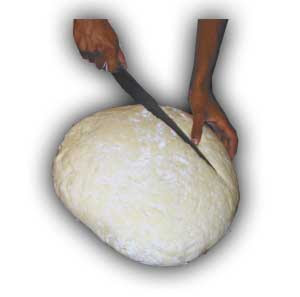 La tâche de malaxer solia être effectué dans une table ou dans un masera, qui était une espèce de poitrine avec des jambes, en dispersant de la farine le long de la cuvette et en jetant la levure et un peu d'eau avec sel, en le donnant retournées et en entraînant peu à peu de la farine vers la masse pour la rendre plus compacte, on ajoutait de l'eau au fur et à mesure qu'elle se terminait et on à malaxer et ainsi successivement jusqu'à terminer avec toute la farine, en en tenant compte du fait que tout au plus montait le volume de la masse davantage d'effort habia que faire pour la manier.Une fois malaxée toute la pâte, on coupait un morceau, il était saupoudré avec farine, on malaxait un peu plus et il était laissé de côté en faisant la même chose avec le reste des morceaux jusqu'à terminer toute la masse.Une fois faites les hogazas on couvrait avec avec une feuille dans l'attente de les introduire dans le four, dans lequel on brûlait des branches d'uz (bruyère) et d'autres arbustes jusqu'à le chauffer, pour réchauffe déjà une fois retirer les braises à la porte du four, balayer le fonds et introduire les hogazas, qui une fois cuites ils seront gardés dans une cuvette jusqu'à leur consommation.
La tâche de malaxer solia être effectué dans une table ou dans un masera, qui était une espèce de poitrine avec des jambes, en dispersant de la farine le long de la cuvette et en jetant la levure et un peu d'eau avec sel, en le donnant retournées et en entraînant peu à peu de la farine vers la masse pour la rendre plus compacte, on ajoutait de l'eau au fur et à mesure qu'elle se terminait et on à malaxer et ainsi successivement jusqu'à terminer avec toute la farine, en en tenant compte du fait que tout au plus montait le volume de la masse davantage d'effort habia que faire pour la manier.Une fois malaxée toute la pâte, on coupait un morceau, il était saupoudré avec farine, on malaxait un peu plus et il était laissé de côté en faisant la même chose avec le reste des morceaux jusqu'à terminer toute la masse.Une fois faites les hogazas on couvrait avec avec une feuille dans l'attente de les introduire dans le four, dans lequel on brûlait des branches d'uz (bruyère) et d'autres arbustes jusqu'à le chauffer, pour réchauffe déjà une fois retirer les braises à la porte du four, balayer le fonds et introduire les hogazas, qui une fois cuites ils seront gardés dans une cuvette jusqu'à leur consommation. 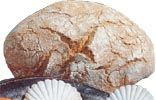 BROA Ou PAIN de MILLO : Il s'avère difficile d'obtenir de nos jours pain de maïs (je jette artisanalement) bien que quelques boulangeries habituent à le cuire, il n'a rien voir avec le pain artisanal de toute la vie. Le Pain de Millo est idéal pour accompagner toute plaque typique galicienne, spéciale pour accompagner la viande de porc et magnifique pour faire grillage et graisser avec beurre. Il s'avère aussi indispensable pour manger les "Rixons" de Porc.
BROA Ou PAIN de MILLO : Il s'avère difficile d'obtenir de nos jours pain de maïs (je jette artisanalement) bien que quelques boulangeries habituent à le cuire, il n'a rien voir avec le pain artisanal de toute la vie. Le Pain de Millo est idéal pour accompagner toute plaque typique galicienne, spéciale pour accompagner la viande de porc et magnifique pour faire grillage et graisser avec beurre. Il s'avère aussi indispensable pour manger les "Rixons" de Porc.INGRÉDIENTS : Farine Maïs, Farine de Seigle, Levure et Sel.
PREPARACIÓN:Se farine en proportion 3 à à 1, se mélangeant avec la levure et en malaxant tout dans ce qui est masera, ajoutons du sel et laissons lavedar. une fois levedada la masse, passées des heures et avec le four (si possible de bois de chauffage) il réchauffe, nous mettons les pièces de pain à l'intérieur pour sa cuisson Après une heure ou une heure et demie, nous ouvrons le four et enlevons le pain avec ce qui est panera.
MASSE de BRONA (Utilisée aussi pour faire pain de brona).
INGRÉDIENTS : 300 grms. de farine de maïs, 150 grms. de farine de blé, 75 grms. de farine de seigle, 250 cc d'eau tiède, 30 grms. de levure pressée de boulangerie, une cucharadilla de sel, 12 cuillerées à soupe d'huile de de ce qui est sofrito (seulement quand il sera pour faire des pâtés).
TOURS Et CONSEILS : Cette masse va très bien pour des mollusques et crustacés (coques, zamburiñas...) et quelques types de poisson (sardines, parrochas... ).La farine de maïs tu puis l'utiliser jaune ou blanche. Nous te recommandons ce qui est blanche, parce qu'il a une saveur plus lisse, mais toujours du pays, ou elle est naturelle et artisanale ; Nous ne te recommandons pas la farine fine d'usine qu'ils vendent dans les herboristerías et les magasins de diététique, puisque ces farines sont pour d'autres utilisations et pas toi saldrÍa avec la texture et la saveur qu'il doit avoir. Avec cette masse, en procédant dans tout égale mais en se passant de l'huile, tu puis élaborer le PAIN de BRONA. Pour le faire, une fois malaxé bolea par la pièce de masse en formant une boule bien foncée et déjala fermenter en lieu tempéré femme voilée et saupoudrée avec farine jusqu'à ce qu'il ait doublé d'excédent son volume. Ensuite cuecela dans le four il réchauffe préalablement à 200 degrés, jusqu'à ce que son écorce et de couleur soit bien toast chocolat. Il procure que le pain de masse ne soit pas dispersé trop pendant la fermentation.
IL EST AINSI FAIT : Il mélange bien les farines et ponlas dans un bol, haz un trou dans le centre et ajoute dans lui l'eau, l'huile et le sel. Mézclalo peu à peu avec une cuillère de bois et commence ensuite à malaxer à main sur une surface lisse jusqu'à obtenir une masse non trop douce, mais lisse et non visqueuse, en ajoutant algo mas de eau ou farine s'il manquait. Nous avons que decirte que cette masse ligue non cogera ni voile comme celle de blé, puisque la farine de maïs est plus vaste. Il forme une boule bien foncée et déjala reposer comme 1 heure avant de l'utiliser jusqu'à ce qu'il ait doublé son volume. Si tu vais rendre des pâtés amasala de nouveau en gramando l'avec quelques cuillerées plus de par huile avant de procéder à estirarla. Cette masse est assez difficile à étendre, étant donné son vastedad que le il fait casser. Ayez probablement qu'apañartelas pour composer le pâté par des morceaux, c'est-à-dire, avec le moule déjà préparé et la lubrification l'étirer et s'il cassait placer amañadamente comme tu puisses les morceaux dans le moule en les unissant ensuite avec les doigts. Peut ayudarte ce qui suit : Enharina très ou un rôle aluminium ou barbe et couperet de tanneur en cuivre sur lui la masse en saupoudrant ensuite légèrement sa surface avec farine, enrollala avec le rouleau avec le rôle et colocala ainsi dans le moule, rellenala et étire également la masse de la couverture (en la couvrant, en la développant avec aide du rouleau mais en la déposant à l'inverse) .

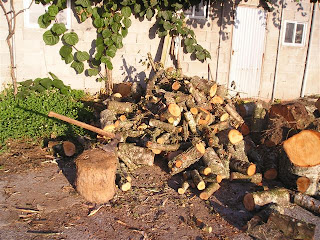
He is doubtless that the bread was to principles del last century a fundamental and essential food, on everything in this town, if at the moment also it is it, we before imagine it when fact and by as much essential era could not be bought to make the bread, one authenticates crafts work, by which practicamente each neighboring tapeworm its corresponding furnace for this work, by as much a time done the separated mesh and in the era the grain of the straw, the rye lay down in "quilmas", fat linen coats also made artisan in house, measuring it in "tegas" before to introduce it in them. These coats were transported to house and the grain one was kept in great coffers, before taking it to the mill to turn it flour and returning to keep it in another coffer. At previous times a bread with a dark color was kneaded single with rye flour being, from half-full of century twenty she was mixed with wheat flour and later bread began to become of wheat. The rye flour was kneaded and it was let puff up, kneading an amount like approximately doing 10 hogazas of a kilo, which would give to eat during 15 days. The main element to knead is the leavening, that was obtained from the previous masada one, guardándo a mass piece, placing it in perol and placing perol next to the fire so that it fermented, keeping it in the trough once it had cooled.


He is doubtless that the bread was to principles del last century a fundamental and essential food, on everything in this town, if at the moment also it is it, we before imagine it when fact and by as much essential era could not be bought to make the bread, one authenticates crafts work, by which practicamente each neighboring tapeworm its corresponding furnace for this work, by as much a time done the separated mesh and in the era the grain of the straw, the rye lay down in "quilmas", fat linen coats also made artisan in house, measuring it in "tegas" before to introduce it in them. These coats were transported to house and the grain one was kept in great coffers, before taking it to the mill to turn it flour and returning to keep it in another coffer. At previous times a bread with a dark color was kneaded single with rye flour being, from half-full of century twenty she was mixed with wheat flour and later bread began to become of wheat. The rye flour was kneaded and it was let puff up, kneading an amount like approximately doing 10 hogazas of a kilo, which would give to eat during 15 days. The main element to knead is the leavening, that was obtained from the previous masada one, guardándo a mass piece, placing it in perol and placing perol next to the fire so that it fermented, keeping it in the trough once it had cooled.
 The work to knead solia to be made in a table or a masera, that was a species of coffer with legs, scattering flour throughout the trough and throwing the leavening and a little of water with salt, giving him returned and little by little dragging flour towards the mass to make it but compact, was added water as it was finished and it was successively continued kneading and asi until finishing with all the flour, considering that whichever but was raising to the volume of the mass but effort habia that to make to handle it. Once kneaded all the paste, a piece was cut, dusted off with flour, a little was kneaded more and it was left to a side doing the same with the rest of the pieces until finishing all the mass. Once done hogazas they were covered with with a savannah to the delay introducing them in the furnace, in which branches of uz were burned (brezo) and other shrubs until heating it, already once warms up to retire live coals to the door of the furnace, to sweep the bottom and to introduce hogazas, that once cooked will keep in a trough until their consumption.
The work to knead solia to be made in a table or a masera, that was a species of coffer with legs, scattering flour throughout the trough and throwing the leavening and a little of water with salt, giving him returned and little by little dragging flour towards the mass to make it but compact, was added water as it was finished and it was successively continued kneading and asi until finishing with all the flour, considering that whichever but was raising to the volume of the mass but effort habia that to make to handle it. Once kneaded all the paste, a piece was cut, dusted off with flour, a little was kneaded more and it was left to a side doing the same with the rest of the pieces until finishing all the mass. Once done hogazas they were covered with with a savannah to the delay introducing them in the furnace, in which branches of uz were burned (brezo) and other shrubs until heating it, already once warms up to retire live coals to the door of the furnace, to sweep the bottom and to introduce hogazas, that once cooked will keep in a trough until their consumption.products of the zone.
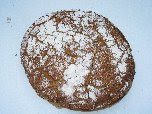 BROA Or BREAD OF MILLO: It is difficult to nowadays obtain to maize bread (I throw artisan) aúnque some bakeries are used to cooking it, does not have anything to do with the bread craftsman of all the life. The Bread of Millo is ideal to accompany any Galician, special typical plate to accompany the meat by magnificent pig and to make toasting and to grease with mantequilla. Also it turns out indispensable to eat the "Rixons" of Pig.
BROA Or BREAD OF MILLO: It is difficult to nowadays obtain to maize bread (I throw artisan) aúnque some bakeries are used to cooking it, does not have anything to do with the bread craftsman of all the life. The Bread of Millo is ideal to accompany any Galician, special typical plate to accompany the meat by magnificent pig and to make toasting and to grease with mantequilla. Also it turns out indispensable to eat the "Rixons" of Pig. INGREDIENTS: Flour of Maiz, Flour of Rye, Leavening and Salt.
PREPARACIÓN:Se flour in proportion 3 to 1, mixing with the leavening and amasándo everything in the masera, we added salt and we left lavedar.Una levedada time the mass, spent hours and with the furnace (if possible of firewood) it warms up, we inside put the bread pieces for his cocción.Después of one hour or hour and average, we opened the furnace and we cleared the bread with the panera.
MASS OF BRONA (also Used to make bread of brona).
INGREDIENTS: 300 grms. of flour of maiz, 150 grms. of flour of wheat, 75 grms. of flour of rye, 250 cc of lukewarm water, 30 grms. of leavening pressed of panaderia, One cucharadilla of salt, 12 soperas spoonfuls of oil of the sofrito (single when it is for making empanadas).
TRICKS And ADVICE: This mass very goes or for seafood (cockles, zamburiñas...) and some types of fish (sardines, parrochas... ).La maiz flour it you can use yellow or white. We recommended the white to you, because it tastes smooth but, but always of pais, that is natural and craftswoman; We did not recommend the fine flour to you of factory that sells in herboristerías and stores of dietetic, since those flours are for other uses and it would not leave with the texture and flavor to you that must have. With this mass, coming in all equal one but doing without the oil, you can elaborate the BRONA BREAD. In order to make it, once kneaded bolea the mass piece forming a dark and déjala to ferment in tempered place woman who hides herself with mantel and dusted affluent ball with flour until it has duplicated very well his volume. Soon cuecela in the previously hot furnace to 200 degrees, until well its crust and of color is toasted chocolate. It tries that the mass bun does not scatter too much during the fermentation.
ASI BECOMES: Affluent mixture the flours and ponlas in a bowl, you do a hole in the center and adds in him the water, the oil and the salt. Mézclalo little by little with a wood spoon and soon begins to knead by hand on a smooth surface until obtaining a mass not too soft, but smooth and nonsticky, adding to something but of water or flour if it were necessary. We have decirte that this noncogera mass binds nor veil like the one of wheat, since the maiz flour is but vast. It forms a dark affluent ball and déjala to rest like 1 hour before using it until it has duplicated its volume. If you are going to make amasala again empanadas gramando it with some spoonfuls but of oil before coming to estirarla.Esta mass it is quite difficult to extend, due to its vastness that makes break. Possibly you have apañartelas to compose the empanada one by pieces, that is to say, with the mold already prepared and lubricated to be stretching it and if it broke to be placing amañadamente as you can the pieces in the mold soon uniting them with the fingers. The following thing can ayudarte: Enharina very or a paper aluminum or of beard and stretches on him the mass slightly dusting soon its surface with flour, enrollala with the roller along with the paper and colocala of this form in the mold, rellenala and stretches also the mass of cover (covering it, developing it with aid of the roller but depositing it the other way around).